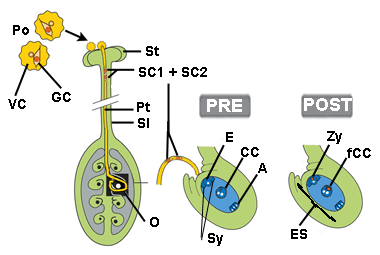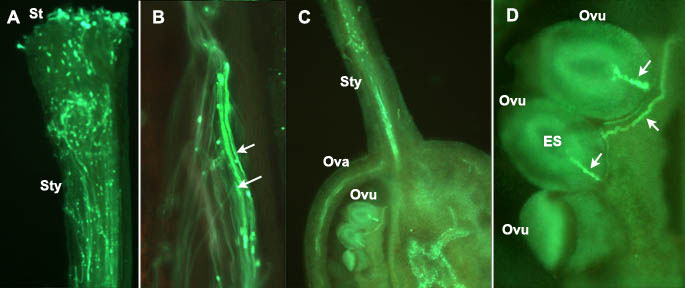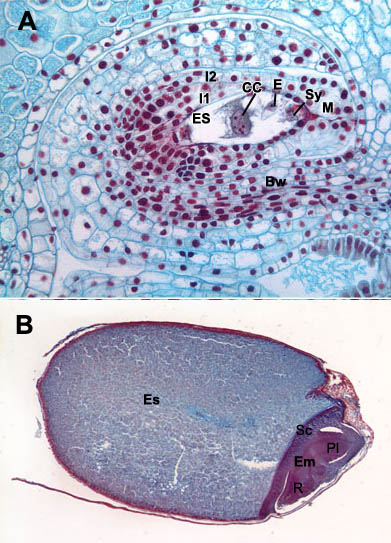Role of the pollen in the fertilization in flowering plants
Pollen grains are the small, male gametophytes which in quiescence, under dessicated conditions, transport the sperm cells tot he pistil of the furtheron immobile flowering plant so that fertilization can be achieved.
| Double fertilization in flowering plants |
 |
|
Pollen grain = Po consisting of a Vegetative cell = VG and a Generative cell = GC, St = Stigma, St = Style, Pt = pollen tube, SC1 en SC2 = Sperm cell 1 and 2, O = ovule containing an embryo sac = ES (PRE = Before and POST = just after fertilization), E = egg cell, Sy = synergides, CC = Central cell, A = Antipodal cells, Zy = zygote, f CC = fertilized Central Cell (forms the endosperm) |
In previous pages we have discussed the
Anatomy of the flower and features around
Pollen development in Flowering plants.
When pollen grains reach a receptive stigma of the same species (Pollination), in principle each vegetative cell of the pollen grain can develop a tube. The much smaller generative cell, or her mitotic products, the two -haploid- sperm cells, are enclosed inside the vegetative compartment and migrate forward along with the growing tube tip. The pollen tube penetrates the stigma and continues to grow through the style to an ovule inside the ovarium. Each ovule contains one embryo sac (ES),in fact a small female gametophyte, bearing a.o. one egg cell and one central cell. When the pollen tube reaches the embryo sac it bursts open and releases the two sperm cells, the actual sex cells. Then double fertilization occurs. One sperm cell fertilizes the egg cell so that a diploid zygote arises, from which an embryo develops. The other sperm cell fertilizes the large central cell in the middle of the embryo sac and give rises through series of divisions to the endosperm, which function as a storage organ of nutrient for the seed. (Sometimes the storage food is transfered from the endosperm to the cotyledons). The ripe dry ovule with the mature embryo and the endosperm is the seed. Fruits are the ripened ovary with inside one (e.g. wheat) or several (e.g. tomato) seed(s).
| Pollen tube growth through the pistil in tomato |
 |
Pollen tubes in a pollinated pistil of tomato (Solanum Lycopersicum cv money maker).
The course of pollen tubes could be visualized by treatment with the fluorescing marker aniline blue that specifically binds to callose, a special cell wall component which is abundant in pollen tubes.
Research project of Kimberly Koens, Bart Schimmel and Maaike de Jong.
A. Pollen tubes growing through the stigma (St) and the style (Sty). B. Detail of pollen tubes (arrows) in the style. The bright spots are callose plugs which separate the living and growing part of the pollen tube in the tip and the remaining degenerating part. C. Fluorescing pollen tubes can be seen in the lower part of the style (Sty)and the underlying ovarium (Ova) containing ovules (Ovu). D. Detail of three ovules (Ovu). The two upper ovules have been penetrated by pollen tubes (arrow) growing toward the embryo sac (ES, corresponding with the dark ovale shape on this photograph). In each pollen tube two sperm cells are present which are involved in double fertilization
|
| Embryosac and mature embryo in plants |  |
A. Transverse section through an ovule of Lily (Lilium sp.).
In the center an embryo sac (ES) can be seen surrounded by its two protective layers the integumenten (I1 and I2). Together they form the ovule. Ovules lay in the lumen of the ovarium. Bw: Inner wall of the ovarium. On one side the integuments come together and a small channel remains open, the micropyle (M),throguh which the pollen tube can penetrate in order to release the sperm cells. Inside the embryo sac the synergiden (Sy) that help conducting the sperm nuclei to the egg cell (E) a bit furtherup is located close the micropyle, whereas the large central cell (CC) is in the center. The embryo develops from the fertilized egg cell, the endosperm (Es) with a nutritional function from the fertilized central cell and the integuments become part of the seed coat.
|
B. Cross section through a cereal fruit, here: Wheat (Triticum aestivum).
According to botanical definitions, wheat grains are single seed fruits. The seed coat, which arises from the integuments, grows together with the ovary wall (pericarp). Such fruit is called a caryopsis and it occurrs nearly exclusively in grasses. The fruit incorporates the endosperm (Es) and the embryo (Em) a complete plantlet with rootlet (= radicula R) and the first leaves (leaf shoot or plumula, Pl). The one cotyledon is transformed into a shield-shaped organ, called scutellum (Sc). The scutellum is appressed against the endosperm and absorbs storage material from the endosperm to transfer it to the growing embryo. |
| Films on pollen tube growth and fertilization |
 |
Click on an image to see a preview of the film by Dr. Olga Erdelska and Dr. Hans-Henning Heunert on double fertilization in plants (in snowdrop; Galanthus nivalis): embryo sac - sperm cells - fertilization of the egg cell - fertilization of the central cell - endosperm formation. Watch all sequences
Source: site of the Institut für den Wissenschaftlichen Film IWF (Note: film can be purchased; preview images used with permission) |
 |
Click on the image banner hereabove to start a small film by dr. I. Lichtscheidl cs on pollen tube growth and fertilization in plants.
Source: site of the department for Cell Physiology and Scientific Film of the university of Vienna)
|
Webpages and photographs:Jan Derksen, Kimberly Koens, Bart Schimmel, Maaike de Jong and Elisabeth Pierson
Drawings: Lidwien van der Horst
Web development: Remco Aalbers







